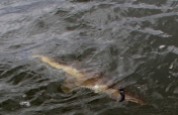Monday
The wind was dropping gradually so I decided to try Bribie Island again, on Monday. As regular readers will have spotted, I find fishing the incoming and high tides much harder around Bribie. On Monday high tide was at 6.36 am. The wind was forecast to get up to about a 10 knot south-easterly by mid-morning.
I was stuck for inspiration on where to fish, so I opted for the flats either side of the old oyster jetty, to start off with. I arrived just after 5.00 am and the wind had dropped off. I started to the south of the bridge and almost immediately caught a tiny (25cm) flathead on a GULP 3” Minnow soft plastic, in the Watermelon Pearl colour. I released it and was treated to a magnificent sunrise. I waded along the edge of the mangroves until I reached the jetty, casting in all directions. Just passed the jetty, I saw a flathead take off from the shallows just in front of me. I stopped and started casting around in a broad arc, starting parallel with the mangrove roots and gradually turning out into deeper water.
There are a lot of rocks on the bottom in this area, so I kept the soft plastic moving fairly quickly. At about 6.10 am, I caught a small flathead that was just about legal size. I let it go feeling confident that I would find something bigger. However, despite trying numerous spots and lots of different plastics, I fished right up to the high tide and through it, without any luck.
As the water slackened off I went for coffee and thought about where to try next. I drove up to White Patch to have a look around. It was now about 8.30 am and the tide was slowly picking up pace on the run out. I drove all the way to the northern most beach access and walked out between the mangroves. This access leads out on to a large area of shallow featureless sand, which is only really deep enough to fish on the bigger high tides.
There are a few weed clumps and depressions and I cast all around these in search of fish. I saw a flathead follow the plastic and then dart away, when it saw me. I moved further south until I reached the area where the weed clumps are thicker and the floor slopes away in to the main channel. I decided to swap up to a bigger, brighter soft plastic as I had not had much luck with the natural coloured minnow that I was using. I loaded a GULP Crazylegs Jerkshad in the Lime Tiger colour on to the jighead and started putting in some long casts, right out to the edge of the channel.
At about 9.30 am I felt a very solid hit and then line started peeling. The fish must have been sitting just beyond the drop off and had struck as the soft plastic swam over it. I felt the leader pulling on the edge of something, so I loosened the drag a little and let the fish take line. It made a couple of big runs and then started to swim back towards me. I took up the slack and kept winding. It was now clear of the drop off and coming into the shallows. It was a big flathead – between about 65 and 75cm long. I never got to measure it. I took my camera out to get a few shots and as I did so it wriggled off the hook and slowly swam away.
That was it, after a few more casts I called time on a fairly frustrating morning of fishing. I looked back at the blog when I got home and realised I have lost a lot of big fish in this area. I will definitely be back.



























